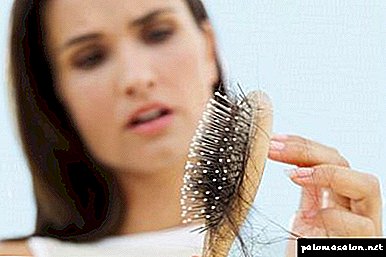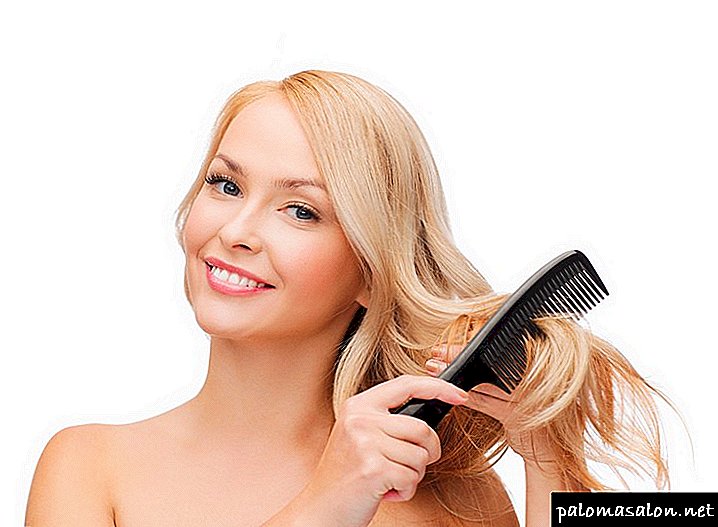In pursuit of perfect-smooth skin, girls go to a lot of tricks, undergo various procedures and look for the perfect, painless and comfortable way of depilation. However, after the session, the legs may please not with a smooth and velvety surface, but with the presence of unattractive hillocks. Their occurrence brings with it a noticeable discomfort: the darkening areas eventually itch, itch and may hurt. Finding signs of ingrowth, women try to solve the problem on their own. How to get rid of ingrown hairs on the legs? First you have to find out the reason for their appearance, and then take up treatment.
Why hair grows
Improper removal of vegetation or genetic or physiological factors can lead to ingrowth. Trouble can begin after a home session, and after going to the beauty salon. If the direction of growth has changed or a thin new hair is not able to grow vertically, leaving behind a layer of epidermis, it remains under the skin, lying horizontally.
Problems provoke the following reasons:
- thick and thick upper skin,
- hormonal changes,
- genetic predisposition
- Incorrect hair removal or depilation
- lack of care for the epidermis before and after removal,
- tight clothing made of synthetic fabrics.
Attention! People with dark curls more often than others suffer from ingrowth. This they owe to the special structure of the curls.
The dense layer of the epidermis is the main cause of ingrowth. Horny scales, closely adjacent to each other, do not miss a new hair, bending it and leaving it inside. In this case, the density can be both a genetic factor and artificially caused by the girl herself. The complete absence or too frequent use of scrubs and peels leads to a thickening of the skin.
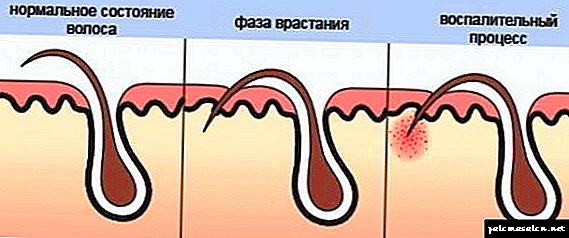
The hormone estrogen, which affects hair growth, can also cause areas with ingrowth. Its production changes under the influence of diseases of the endocrine system and the thyroid gland, monthly menstruation or during puberty.
The refusal of the procedure of preparing the skin for depilation can turn out to be rather sad. Unsplit epidermis with dead cells will necessarily lead to the appearance of problem areas. The lack of a disinfectant treatment after a session can trigger the process of inflammation and cause a serious infection.
Tight clothing made of materials that do not allow air and the natural release of fluids, causes a "greenhouse effect" and does not allow the skin to breathe. It exerts pressure and additionally injures the epidermis, which has not yet managed to heal after a session of vegetation removal. If you put on the wrong thing immediately after depilation, you can artificially make the skin seal and clog the hair follicles, preventing them from developing naturally, and as a result get ugly bumps and trouble.
Causes of hair ingrowth after epilation, shugaring, shaving
In addition to physiological factors and the lack of proper care, the removal procedure itself, carried out incorrectly, can have unpleasant consequences.
Depilation must be done strictly in the direction of growth. The razor is kept gently, without pressure, and foam, cream or shaving lotion is used for slipping.
Attention! In no case can not use the shower gel or regular soap. They will not give the desired effect and can lead to microtraumas.
The tool must be individualized, with a sharp blade. After each holding on the skin should be washed.The session should be finished by treating the hands with an antiseptic first, and then the places where the depilation was carried out, then it is recommended to apply a remedy that soothes and slows the growth of hair.
Epilation with wax or epilator, like shugaring are equally dangerous: if the hair is caught incorrectly, only its part that protrudes to the surface is pulled out, and the canal and the mouth are injured. After that, the follicle becomes inflamed, ingrowth begins: a new hair grows horizontally, spirals, or folds under a skin with a bundle.
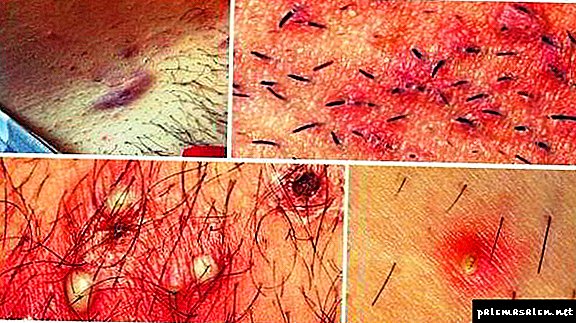
Epilation is performed on dry, pre-cooled skin. The strips are attached in the direction of growth and are removed against one sharp and quick movement. The skin is treated with a disinfectant and, additionally, with a cream or lotion, which slows the growth rate of the vegetation. For the prevention of ingrowth, you should use an antiseptic every day and additionally apply an ointment with the properties of an antibiotic.
First symptoms
The first signs of ingrowth are pain and itching, however, in the same way, the skin can react to depilation. In this case, irritation and redness will quickly subside, but if the sensations do not pass away - this is a sign of growing.
The exact symptom will be the tracing of the connection between the appearance of ingrown hair and the depilation session: problem areas appear only during the epilation period or disappear with its termination or interruption.
Externally, areas with emerging problems are easy enough to notice: they are distinguished by the appearance of cones and bumps. As the inflammation increases, irregularities can become filled with pus or remain red and hard, resembling acne.
Attention! You can not open the boils with pus on their own. An incorrect procedure can result in blood poisoning and serious infection.
Growing up causes hyperpigmentation: around the grown hair, the epidermis noticeably darkens. The deterioration of the stage of the disease is able to extend the process of changing the color of the skin to the neighboring areas. The consequences will have to eliminate a long and painstakingly.
If you leave the bumps without treatment, they will not disappear over time: they can grow and shrink in size, giving hope. Without intervention in the course of the disease, the tubercles will spread to a large area and start the process of inflammation by going to tissues without ingrowth. In this case, after the removal of infected areas on the skin will remain scars and areas with darkened skin.
What to do at the first sign
If itching or redness occurs, causing discomfort and not passing for two to three days, you should completely refuse epilation. The break should continue until the annoyance disappears. After this, the method of vegetation removal should be changed.
Elimination of foci of ingrowth will take a fairly large amount of time, but in no case should you rush the process, you can only ease it. The methods vary from light and prophylactic to mechanical intervention, which is best avoided and applied only if other methods do not help.
If the lesions with inflammation did not have time to capture a large area, the usual steaming will help. It is enough to take a hot bath to help the stuck items come out. The influx of hot water will accelerate blood circulation and open the pores, spreading the tightly lying scales of the epidermis. For an additional effect, a hard washcloth is used: massaging is carried out without strong pressure, in order to only remove dead cells, but not to injure the skin.
Attention! Steaming is suitable only for the initial stage. In no case can not apply this method in the presence of boils and pustules: prolonged water procedures can provoke their opening and subsequent infection.
If the hair is deep enough, steaming may not work.To facilitate the way up, a scrub is applied: after massaging, the problem can be solved independently. The rod will change the direction of growth and come out. Peeling can have a stronger effect and at the same time antiseptic: it, unlike the scrub, affects not only the upper layers of the epithelium.
The mechanical method is applied only as a last resort if there are up to two problem lesions.
- Previously, the epidermis is steamed using a hot bath or shower. You can use a towel soaked in warm water as a compress.
- The surface is massaged with a scrub or peeling.
- Hands and a site with inflammation are treated with a disinfectant. You can use ordinary alcohol, spray or ointment with antiseptic properties.
- Additionally processed tweezers. With its sharp end you need to pick up the hair and gently pull it to the surface of the skin. The place is immediately disinfected. Tweezers and hands during the procedure should be as sterile as possible.
- Disinfection continues for 5 days after removal. Additionally, an antibiotic ointment is used to prevent the risk of infection.
With the development of purulent tubercles or cones, treatment is best left to a professional. First you have to go to the beautician for examination and accurate diagnosis. Growing up can be confused with various forms of dermatitis. After that the direction to the surgeon is written out.
Attention! Absorbs can be opened independently: besides pus, one or two hairs come out of them. In this case, the wound is necessarily worth sanitized and treated with antibiotic ointment.
What should not be done in any case
Fighting at home is a risky business. When using the wrong means or error during the procedure, it is easy to infect the internal tissues. In addition, there is a certain danger if you do not take any measures and leave irritation without attention.
However, even good intentions can lead to infection. In no case can not pick the inflamed area, try to squeeze out the hair. So you can only disturb the wound, increase it and seriously injure the epidermis. After extrusion may well appear scar and scar.
When using scrubbing or peeling agents, do not forget about moisturizing. Without it, the skin will dry out and the following procedure for depilation will cause severe irritation. Too frequent scrubbing can cause epidermis compaction: cells can begin to divide too intensely and block the channels of the follicles.
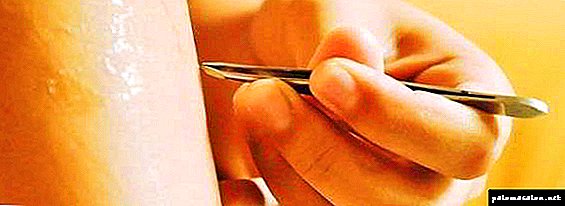
In any case, abscesses with pus should not be opened on their own, even when using ointments and compresses to draw out dead blood cells. The risk of infection is too great. Also, with the appearance of papules - red hard bumps - you can not squeeze them. As in the case of acne on the face, excessive pressure can injure the skin, increase inflammation and its area of spread. Squeezing also leads to the formation of scars and scars.
Attention! If none of the methods worked, you should contact a dermatologist for professional help.
Salon ways to remove ingrown hair
When ingrowth moves from rare incidents to a constant trend, and domestic procedures do not produce results, it makes sense to solve the problem forever. Epilation carried out in beauty salons or medical centers, has a permanent or long-lasting effect. For a few procedures from unwanted vegetation, you can get rid of completely or significantly increase the time between sessions of hair removal.

Electrolysis
Regardless of the depth of the hair, the method works flawlessly. The needle-electrode is inserted under the skin, current is passed through it and the follicle is destroyed. Hair comes out naturally.Also, electrolysis is a good way to remove unwanted vegetation forever, although the full course will take a long time.
How to get rid of leg hair at home after epilation, shugaring recipes
Before the appointment of a fairly expensive salon procedures, you can try to cope on their own. If the skin has a high degree of sensitivity, home care will be the ideal option. The risk of allergy is significantly reduced: the components are controlled and, if you are hypersensitive, they can be replaced by a suitable analogue.
Bodyaga and hydrogen peroxide
The tool has an excellent peeling effect and is applied in a course of 5-7 sessions. Bodyagi powder is mixed with hydrogen peroxide 3% to the consistency of sour cream and applied as a compress on the area for 10-15 minutes.
The product, familiar to all owners of acne, copes well with ingrown hair. The lotion also combats scar formation and eliminates inflammation. It is applied locally: a solution is applied to a cotton pad and applied to the problem area. After a week course, the path for the follicle will be released. To eliminate skin dryness in parallel, you should use moisturizers with a gel texture and soothing properties.
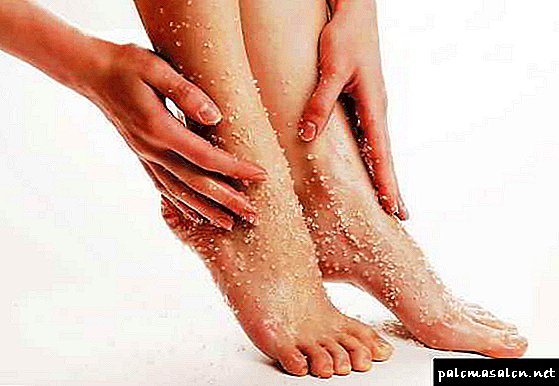
- crush 2 tablets with a spoon. Dissolve them in 30 ml of water,
- apply the resulting gruel to the desired area. Glycerin can be added to the mix,
- after 30 minutes, gently remove with a damp cotton swab.
Saline for ingrown hair removal
Sea salt has anti-inflammatory properties and at the same time is capable of removing a layer of dead cells that impede the exit of the rod to the surface. Saline solution procedure:
- Mix 100 grams of coarse sea salt with aromatic lavender oil (20 ml) and orange (20 ml). If desired, you can add an additional component for the smell.
- Add 30 ml of moisturizer.
- Apply the mixture on your feet and massage for 5 minutes. Leave on the skin for 1-2 minutes.
- Rinse with cold water and dry towel scrubbing.
- Treat the area with a cotton pad moistened with salicylic solution.
- Wait for absorption. Moisturize with a baby cream or a light remedy with a calming effect.
Attention! Do not use components with comedogenic properties. This will clog the pores and worsen the situation.
Scrubs for getting rid of ingrown hairs recipes
Scrubbing is ideal for prophylaxis. The procedure can be performed using your favorite component, turning the fight against an unpleasant event into an aromatherapy and relaxation session.
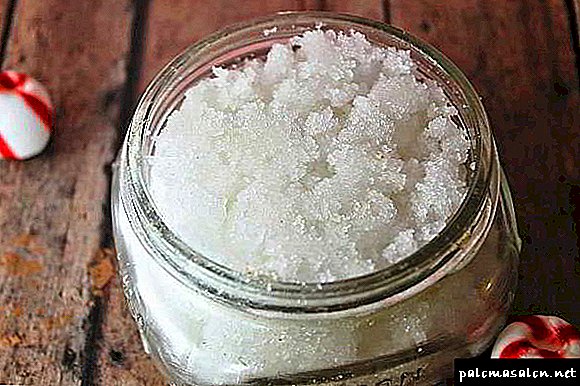
- 30 grams of rice flour or rice, crushed in a coffee grinder, dilute 40 ml of water.
- add 15 ml of aloe juice.
- apply the mixture on your feet and massage.
30 grams of ground coffee mixed with 30 grams of sugar. Add peach, coconut, lemon or orange oil in the amount of 40-50 ml. For flavor you can use a little cinnamon.
Oatmeal Scrub
- grind flakes in a coffee grinder: you need 30 g,
- add mashed grapes: from 7 to 10 berries,
- pour 50 ml of milk. Stir to a creamy consistency.
The composition has a gentle and delicate effect, suitable for sensitive skin. 40-60 g of corn flour mixed in a 1: 1 ratio with aloe juice. The mixture should be as homogeneous as possible.
Attention! The use of scrubs for open wounds or the presence of purulent inflammation is prohibited.
Lotions and cream against ingrown hair
In addition to using home remedies, you should pay attention to pharmacy products. Cream and lotions with softening properties and anti-inflammatory effect are suitable for combating ingrowth and will not harm the skin.
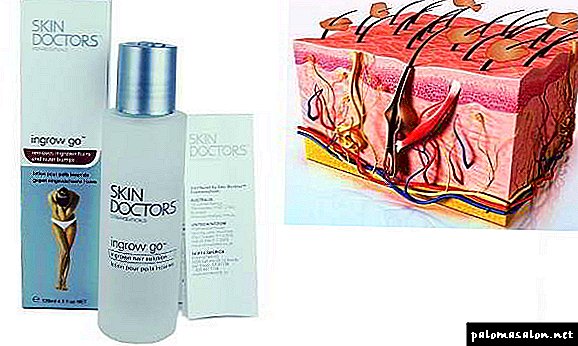
Popular creams:
- "Follivit." Helps eliminate itching and inflammation, sets the right direction for the growth of vegetation. Prevents re-ingrowth.
- Creme with tretinoin. They have the ability to mix in inflammations and speed up their healing.In addition, they affect the upper layer of the epidermis, reducing it.
- Cream "Foli-End" from the company Beauty Image. Relieves irritation and heals wounds. It contains AHA-acid: do not use it if the treated area is exposed to direct sunlight. After application, the stuck elements themselves appear on the surface. The risk of re-ingestion is reduced to zero.
- Lotion "Ingrow go" from Skin Doctors. Also contains AHA-acid. Copes with both the initial stage and the consequences in the form of red bumps. Removes irritation. Apply only point.
- Lotion "Gloria Sugaring". It is sprayed immediately after epilation. Effectively fights with ingrowth. Thanks to its constituent acids, it accelerates the regeneration of the epidermis and removes dead cells. Slows down vegetation growth.
Attention! Before use, a test for the absence of an allergic reaction is required. For this tool is applied to the elbow bend and left for 30 minutes.
Reasons why hair on your legs grows
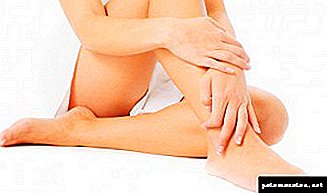
Contrary to the general opinion, hair grows equally after both depilation and epilation. In the first case, the cause is injury to the epidermis during shaving of excess vegetation.
This leads to dry skin and prevents the hair from breaking through the crust; it has to grow inside the body. Epilation simply thinns and weakens the hairs and therefore they do not have enough strength to penetrate the dermis.
After removing unwanted vegetation in any way, a change in the direction of growth of the rod may occur and, as a result, hair will grow. This is influenced by several factors, the main is the wrong care of the covering of the body after the procedure.
Who has the nature of ingrowth:
- people with curly hair,
- owners of thin on the nature of the locks,
- people who suffer from abnormal hair growth,
- those with very dry skin.
What is ingrown hair
A hair that does not grow outward, but under the skin (intradermally) is called ingrown hair.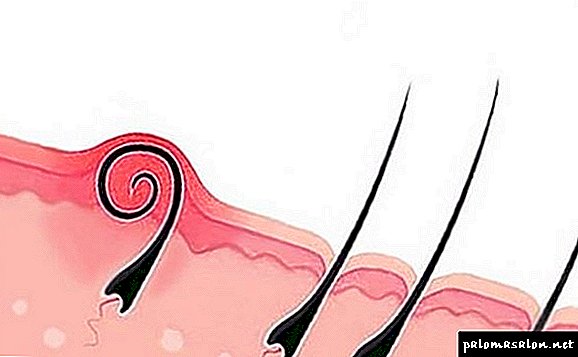 Hair that has not broken through the skin and grows subcutaneously is called ingrown
Hair that has not broken through the skin and grows subcutaneously is called ingrown
It can be easily identified by the following features:
- the appearance of local redness and puffiness
- the occurrence of pain or itching,
- seals and bumps,
- dark bumps on the surface of the skin,
- pustules with a hair under the skin in the center of inflammation,
- looking through the hairs under the skin.
Causes of the problem
Ingrown hairs on the legs appear if the technique of their removal with a razor, electric epilator, wax or sugar depilation was disturbed. With an illiterate procedure, the hairs often break off, and the hair follicle is injured. Then a scar of connective tissue forms at the site of injury, which narrows the mouth of the follicle and contributes to changing its position. As a result, the hair begins to grow not outward, but subcutaneously, and it is difficult for it to break through to the surface.
There are several reasons causing the breaking of hairs and follicular injury:
- no tension of the skin surface during the procedure. The hair root is fairly tightly held in the skin layers, and if the skin is not well stretched when the hair is removed by an electrolytic electrolysis machine, wax or sugar paste, the hair root remains in place, but will be injured,
- Incorrectly selected angle of depilation. Each type of hair removal uses its own angle of pulling. If you do not stick to it, the hair at the time of the breakthrough will break off, and the follicle will be damaged,
- bad materials and tools. When using tools and materials of poor quality, the hairs will not be removed along with the roots, but cut off, while the hair follicles will change their position,
- inappropriate hair length.Short hairs are not reliably caught by the epilator, paste or wax and often remain in place at the time of separation, but their follicles are injured by external force. Long hairs are not captured over their entire length, so they break off during the snatch and the roots are damaged. The optimal hair length for all types of hair removal is 4–5 mm.
However, not always mistakes during depilation cause the growth of hair on the legs. Sometimes even with perfect observance of all the rules and recommendations, the problem still appears. In this case, the physiological features of the organism are to blame.
The cause of the ingrown hair on the legs often becomes skin that is thick by nature. Through this skin, the hairs are difficult to break through to the surface, so they grow intradermally.
If the hairs on the legs themselves are hard and thick, then they have rather strong and large follicles that are difficult to pull out of the skin at the time of depilation. Consequently, during the snatch, the hair may break, and the follicles change their position.
Too thin hairs can also grow due to the lack of strength to break through the stratum to the surface of the skin.
Lotion Depileve Lotions Bottle
Depileve Lotions Bottle anti-ingrown hair lotion incorporates salicylic acid, which softens and exfoliates the keratinous layer of skin, which means it helps the new hairs to break through to the surface. In addition, the tool relieves inflammation, effectively moisturizes the skin and restores it. Cons of lotion consumers attributed to its smell.
The manufacturer recommends wiping the skin immediately after depilation. 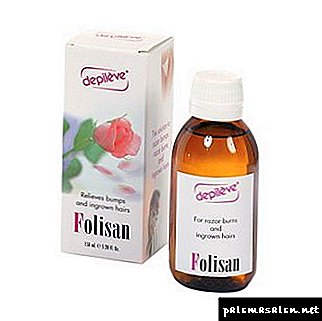 Depileve Lotions Bottle lotion not only helps to clean ingrown hair, but also moisturizes the skin.
Depileve Lotions Bottle lotion not only helps to clean ingrown hair, but also moisturizes the skin.
Beauty Image With AHA Acids Concentrated Cream
Concentrated cream contains lemongrass extract with fruit acids. They moisturize, soften the skin and exfoliate dead skin cells. The tool can prevent irritation and itching, as well as soothe and restore the skin.
To prevent ingrown hairs after the procedure, the cream should be applied daily to the skin for 2 weeks. 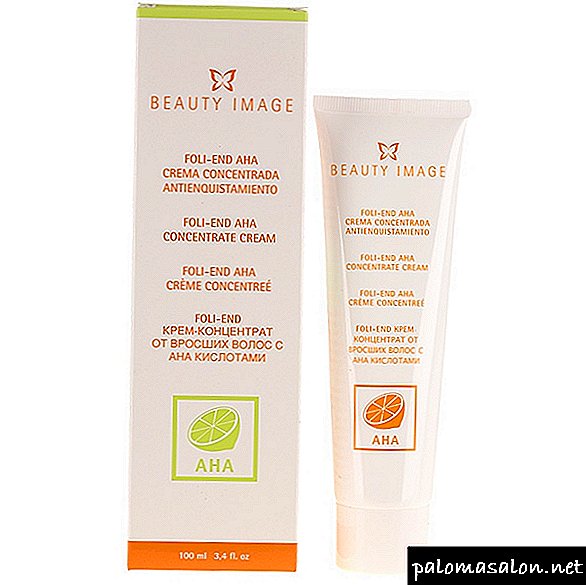 The product contains fruit acids that dissolve the top layer of skin.
The product contains fruit acids that dissolve the top layer of skin.
Gel from ingrown hairs GLORIA
The active substance is salicylic acid. The gel not only helps to eliminate already existing ingrown hairs by exfoliating the skin, but also stops further ingrowth. In addition, if the tool is applied immediately after depilation, it will slow down hair growth.
The gel should be applied twice a week on clean, dry skin. 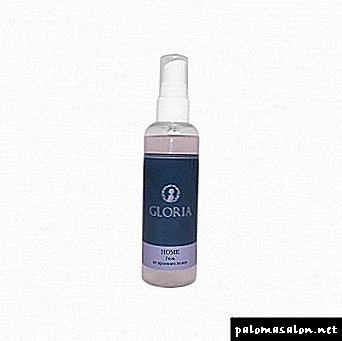 Means significantly slows hair growth
Means significantly slows hair growth
Serum after depilation White line Avocado
The whey composition is rich in plant extracts (chamomile, papaya, lemon, avacado), and also contains menthol, shea butter, olive, sunflower, sweet almond. Due to this content, the serum fights with ingrown hairs and intensively moisturizes the skin, cools and soothes it.
Means is used daily until hairs sprout. 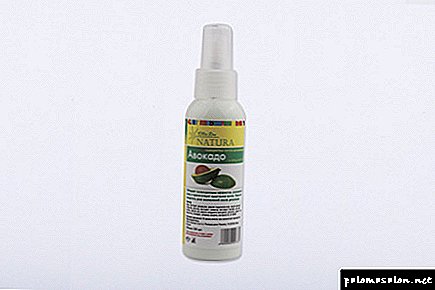 Serum after depilation White line Avocado contains extracts of many plants, as well as healing oils
Serum after depilation White line Avocado contains extracts of many plants, as well as healing oils
Bliss wheels from ingrown hair
After depilation it is convenient to use cotton pads soaked in a special compound against ingrown hair. Active substances that soften and exfoliate the stratum corneum are salicylic and glycolic acid. Green tea extracts and oatmeal have a soothing and calming effect.
According to consumers, the tool really effectively eliminates ingrown hair. The only downside to Bliss drives is their high price.
One disc is enough to handle one leg from the ankle to the knee. Feet need to wipe discs 2 times a week. 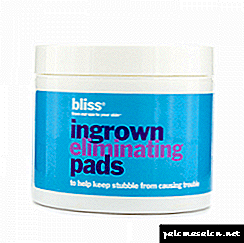 One disc is enough to handle one leg from the ankle to the knee
One disc is enough to handle one leg from the ankle to the knee
Hasnaa Ant Oil
The undoubted advantage of formic oil over other means against ingrown hair is its absolutely natural composition.
With regular use of formic hair, hair significantly slows down its growth, and their ingrowth is prevented. In addition, the skin gets intense hydration, it becomes soft and smooth.
Ant oil should be applied to clean, dry skin and rinse with warm water and soap after 2 hours.  Ant oil can boast of its absolute naturalness.
Ant oil can boast of its absolute naturalness.
ARAVIA Professional 2 in 1 spray lotion
The product contains fruit acids, softening and removing the top layer of skin. Plus, the spray significantly slows the growth rate of hairs, because its components adversely affect the hair follicle.
Spray lotion should be used every day for 2 weeks. The spray is sprayed onto the skin and left until completely absorbed. 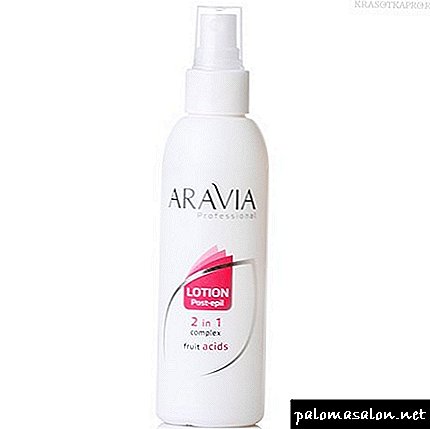 Spray need to use the course in 2 weeks
Spray need to use the course in 2 weeks
Recipe from the author. If you pay attention to the compositions of anti-ingrown hairs, most of them contain salicylic acid as the main active ingredient. Therefore, salicylic ointment can be used to combat ingrowth. But since dermatologists do not recommend using it in its pure form, the drug can be combined with zinc ointment and Bepanten. Zinc ointment dries the place of ingrown hair, and Bepanten has antiseptic properties and prevents inflammation. To prepare an ointment against ingrown hairs, you should take an equal amount of all three drugs, mix them together and lubricate the skin of the legs 2 times a week.
In addition to the use of special means for ingrown hair, there are other methods of dealing with the problem. If the hair has grown under the skin and suppurations have not formed around it, then the skin can be treated with a scrub. Solid particles will remove the cornified layer and “free” the hair that has not penetrated. It will remain only to pull out with tweezers, and the place of ingrowth can be treated with an antiseptic (for example, Chlorhexidine).
Council Before applying the scrub, the skin of the legs is desirable to steam in a hot shower. Then the skin will soften, and the cornified cells will more easily exfoliate from the surface.
Note by the author. Scrubs can be made independently. Moisturizing shower gel is used as a base. Ground coffee beans, flax seeds, almond kernels, salt, and sugar can play the role of abrasive material. To prepare the scrub, mix a tablespoon of gel and a tablespoon of solid particles.
As a basis for home scrub for feet you can take aloe juice. The skin on the legs is distinguished by increased dryness, and the hair root is difficult to remove from it. Moisturizing the skin of the legs makes it soft and prevents the appearance of ingrown hair. Aloe juice has powerful moisturizing, anti-inflammatory and healing properties. Therefore, it is often used as a base for scrubs. 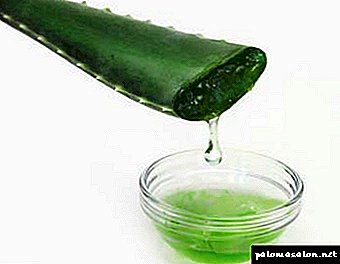 Aloe vera has moisturizing properties, which is important for the skin of the feet.
Aloe vera has moisturizing properties, which is important for the skin of the feet.
Why is this happening
Ingrown hair is a hair that does not grow outward, but develops subcutaneously (intradermally). It is possible to understand that ingrowth has appeared on the skin surface according to the following features:
- redness and puffiness
- itching
- local pain,
- seals
- pustules with a hair in the center,
- hairs that are visible under the top layer of skin.
Removal of ingrown hair with suppuration
When the pathological microflora enters the follicle of the ingrown hair, an abscess forms on the skin surface. Many try to squeeze it. But this, in any case, can not be done! The fact is that with a strong external pressure the follicle will be necessarily injured, which will lead to a change in its position and further hair ingrowth.
Remove ingrown hair with abscess should be as follows.
- To disinfect a problem place and a thin needle.
- With the end of the needle make a puncture in the abscess.
- Pry off the ingrown hair and pull it to the surface.
- Remove hair with tweezers.
- The ingrowing site should be lubricated with an antiseptic (hydrogen peroxide, Chlorhexidine, Miramistin, etc.).
Non-compliance with the rules of depilation
Recently, women use the razor less and less. Ladies prefer to use electric epilator, wax or sugar depilation, because these methods allow you to remove hairs with roots, and, accordingly, the effect after the procedure lasts at least 2 weeks.
However, if mistakes were made during the session, the hair may break off and its follicle may be injured.. During the healing process, a scar is formed from the connective tissue, which significantly narrows the mouth of the follicle and contributes to changing its position. Together, this leads to the fact that the hair begins to grow intradermally.
The follicle gets damaged and changes its direction for the following reasons:
- weak skin tension at the time of depilation. The root of a hair tightly held in the skin, so at the time of its removal in the absence of proper tension of the skin, the hair can only break off, and its follicle can be injured,
- Wrong hair pulling angle. Each method provides a certain angle at which hairs should be removed. If you do not comply with it, the likelihood of follicle damage increases,
- substandard materials and tools. When using low-grade consumables or tools, there will not be a reliable grip on the hair, therefore, after their removal, the likelihood of further growth will be high,
- inappropriate hair length. For all types of home depilation, the optimal hair length before the procedure should be 3–7 mm. If the hairs are shorter, they will not reliably capture the epilator tweezers, sugar paste or wax. Therefore, at the time of the jerk of the hair, it simply twitches strongly, but remains in place, but its follicle will be damaged. Long hair will not be captured over the entire length, and if detached, there is a high probability that it will break. The follicle is exposed to a strong external influence and is injured.
Preventive measures
Any problem is easier to prevent than to find ways to solve it. The appearance of ingrown hairs on the legs can also be prevented. To do this, follow the recommendations of skin preparation specialists before depilation and proper care after a session.
Before the procedure, do the following:
- for 10–15 days, the skin of the feet should be intensively moistened with cosmetic or home remedies (aloe vera juice, fresh cucumber, olive oil, etc.),
- the day before the procedure, the skin surface of the feet should be treated with a scrub. This will remove the cornified layer, which will make it easier to pull out the hairs and minimize their further ingrowth.
After the procedure, it is also necessary to carry out a set of measures that will reduce the risk of hair ingrowth:
- no later than a day to use cosmetic compositions against hair ingrowth. These funds are applied by courses or 2-3 times a week.
- at least 2 times a week, the skin of the feet should be treated with a scrub,
- 2-3 days after depilation, one should not wear tight trousers, since additional friction on the skin of the legs creates the risk of changing the position of the hair follicles.
Body features
Sometimes “victims” of ingrown hairs are people with certain physiological features.
If the person has thick skin on his legs, then often the hairs simply physically cannot penetrate through its layer.
Owners of too hard and thick hair often suffer from ingrowth. This is explained by the fact that the roots of such hair firmly held in the skin, and they are difficult to pull out. Most often during depilation, the hairs break off and begin to grow subcutaneously.
Those with weak and thin hairs are also susceptible to the appearance of ingrown hair, since the hairs are not able to break through to the surface of the skin.
Undesirable effects of hair ingrowth
Ingrown hairs in some cases can cause unpleasant consequences.
Sores appear in case of unsuccessful and careless removal of ingrown hairs. Serve the appearance of wounds and the presence of extensive suppurations around the ingrowth.
The site of damage must be disinfected, treated with salicylic ointment and covered with a sterile dressing on top. The procedure should be repeated 2 times a day.
Also, twice a day, you can use Rescue-man balm, which on the surface of the wound creates an invisible protective film and contributes to the tightening of damaged skin.
Eplan's antibacterial and disinfecting cream effectively heals wounds. It should be applied twice a day.
Scrub Use
In the case when there are no inflammatory processes around the ingrown hair, you can fix the problem with scrubs. Abrasive grains will remove the top keratinized layer, and the hair will be on the surface of the skin.
At home, scrubs can be done independently. To do this, mix the following ingredients:
- basis - 1 tbsp. l.,
- solid particles - 1 tbsp. l
The basis of the scrub can be ordinary shower gel, olive oil or aloe pulp.
Olive oil effectively nourishes, softens and moisturizes the skin, and its vitamin E has a rejuvenating effect, gives the skin firmness and elasticity. Aloe pulp has anti-inflammatory, healing and moisturizing effects.
As abrasive particles, ground coffee beans, flax seeds, salt crystals (sea or cook), sugar, etc. are used.
The skin is processed in the following sequence:
- Take a hot shower. Under the influence of temperature, the skin is steamed out and softened, and the cornified cells exfoliate more easily.
- Apply the scrub on the problem areas and in a circular motion to massage the skin. The hair should appear outside.
- After treatment, wash off the scrub with warm water.
- Wipe the skin dry.
- Loose hair should be removed with tweezers.
- Lubricate the place where the ingrown hair was Chlorhexidine or hydrogen peroxide.
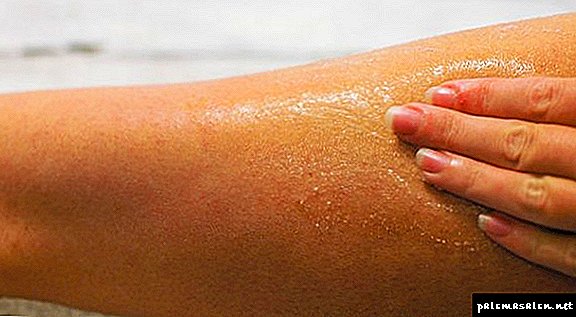
Blue spots
Sometimes on the place of ingrown hairs, spots of a bluish tint are formed, which are nothing more than small hematomas. When the follicle is injured, there is a rupture of the capillaries that feed it. Part of the blood flows into the extracellular space and thickens there. Outwardly, this is manifested by a change in skin color.  Blue spots may appear on the site of ingrown hair.
Blue spots may appear on the site of ingrown hair.
To eliminate bruises, it is recommended to use special hematoma remedies: Ambulance, Badyaga 911, Bruise Off and others. Typically, the drug is applied to the blue spot 2-3 times a day until the bruise completely disappears.
Popular recipe from the author. Bruises after ingrown hair can be removed with the help of camphor oil or alcohol, which has warming properties and promotes the resorption of hematomas.
Camphor oil or alcohol should be heated to 38–40 ° C, wetted with a cotton pad and applied to the problem area. Fix the disc with adhesive tape and leave overnight. Applications should be done daily until the problem disappears.
Cones and acne
Sometimes in the place where ingrown hair appeared, inflammatory processes begin, as a result of which lumps or compressed acne are formed. In this case, they need to be eliminated with the help of soft scrubs. But if the seals are large or painful, you should immediately seek medical attention.
If there were extensive suppurations around the ingrown hair, then after its removal a deep wound can remain, and later on a scar. To eliminate this effect, medical ointments can be used: Kontraktubeks, Dermatiks, Klirvin, Kelofibraza, Zeraderm Ultra, etc. The preparation is applied to the skin according to the annotation (usually 1-3 times a day).Treatment of scars and scars lasts a long time - 3-6 months. And the older the scar, the longer you need to fight it.
Boils and abscesses
Furunculosis develops when the ingrown hair does not grow along the skin surface, but deep into it, and reaches the hair follicle. In this case, the follicle can be infected, and then inflammation begins. Outwardly, this is manifested by redness and compaction of tissues, soreness and the presence of a purulent-necrotic core. 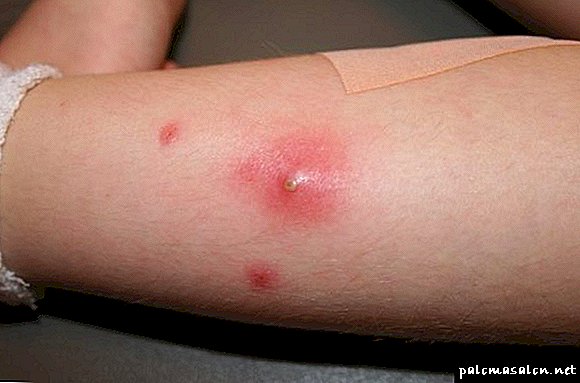 When the hair follicle becomes inflamed, furunculosis develops.
When the hair follicle becomes inflamed, furunculosis develops.
If a non-sterile needle was used to remove an ingrown hair, in this case infection of the tissues around the hair is possible, and all the conditions are created for the occurrence of an abscess - purulent inflammation of the skin layers with the formation of a purulent cavity.
Boils and abscesses should not be treated at home. Here you need the help of a doctor who will competently uncover inflammation and prescribe the necessary antibiotic therapy.
A good lotion Depileve Lotions Bottle. I took the "mini-version" 10ml with a roller applicator for the sample. When used on the feet once after the inquisition, the electroepilator relieves irritation well. For the treatment and prevention of ingrown hairs, I can’t say that “just super”, but in general, a good effect, even a week has not passed, and the inflamed acne has become much less. But I additionally scrub my feet daily with a hard washcloth, without this in any way.
Antonina
Ant oil (Morocco) has an excellent natural composition, has no chemical components. I use ant oil not so long ago, about six months. But now I can make certain positive conclusions. Definitely slowed down hair growth. It used to be epilated every week, now the interim period reaches 4 weeks, which is quite a lot.
SunnyRita
Gloria gel has a stunning smell of fresh apples, a cooling effect. Apply to the area with light movements, quickly absorbed. And most importantly - it really helps! Using the gel from ingrown hairs 2-3 times a week REGULARLY, you will succeed and forget forever what is ingrown hair. But do not forget that if you have already encountered such a problem once, then you will not run away from it. Without the right care, ingrown hairs will appear again and again. With constant use of this gel, you can be sure of yourself and your beauty.
ananasik32
Previously, she was very, very suffering, from black spots on her legs, now there are none at all and I am extremely happy. Thanks to the cream concentrate from ingrown hair Beauty Image With AHA acids. True, it helped a lot, and it’s not so straightforward that it’s quite expensive, as it seems to me / and this is a plus /. Especially since the result is so good. She began to wear short dresses without fear that I had something visible somewhere. But I have a problem that I do not use. Epilator, razor, wax strips, now nothing bothers me, I am glad that I purchased this wonderful tool. I advise everyone to buy it! No more jeans in the summer, just dresses, skirts and shorts. Eh, you really will not regret. Thank him so much!
Kooki
The main reason for the appearance of ingrown hair on his legs are errors during depilation. You can fix the problem with scrubs, as well as needles and tweezers. But it is better to prevent the ingrowth of hair using special tools and compliance with the recommendations on the preparation of the skin for the procedure and care of the skin after depilation.
Causes of hair ingrowing on the legs after treatment with the epilator
At the moment, all the girls want to have a smooth skin on the body - primarily on the legs. In this situation, the woman removes the excess hair with a razor, epilator or wax.
However, after epilation a change in the structure of the regrown hair occurs - new hairs become thicker. As a result, the hairs begin to grow into the skin, and not sprout out.In this situation, the hair bends and continues to grow under the skin - as a result, ingrown hair is formed.

Most girls can use only 1 of 3 of the above methods of hair removal, which they must bring to automatism and effectively use.
When shaving hairs, electric hair removal or using wax, the girl captures only the outer part of the hair, and leaves the root part and the follicle in the same place. As a result, a woman has skin inflammation and irritation.
As a result, when a woman has ingrown hairs on her leg, the following problems appear:
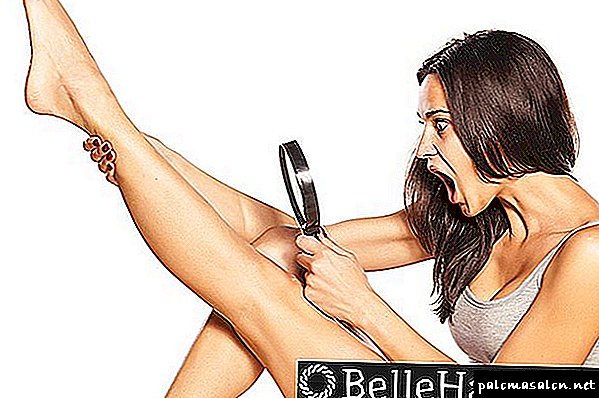
Causes of ingrown hair
If you remove unwanted vegetation by any of the mechanical methods, the possibility of ingrown hairs is very great. Basically, they appear after applying a razor, cream or wax strips. The fact is that these methods remove only the upper part of the hair, without affecting the follicle. Each depilation procedure makes them thinner and weaker, and over time it is difficult for them to break through the keratinized epidermis scales. Then the hair begins to grow under the skin, gradually twisting into a tight spiral. By themselves, such cases are not uncommon, sometimes due to the pressure of the hairs still break out on their own, but more often without external influence they are not able to overcome a thick layer of keratinized skin.
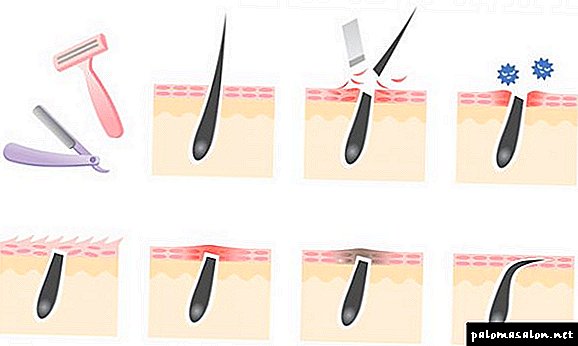
Ingrown hairs look unaesthetic and can cause itching, redness and even festering of the skin.
The culprit of such a problem is often not the depilation itself, but improper care before and after the procedure. If we forget about it, the skin on the legs becomes rough, the pores are clogged with dead cells, and it becomes difficult for the hair to break through. It is non-compliance with the following rules that causes ingrown hair:
- carefully prepare the skin - peel and moisturize before depilation. For gentle areas of bikini, legs and underarms shaving or the use of wax strips - this is a shock, you should not aggravate the situation, forgetting about the care procedures and scrubbing,
- use only a sharp razor and remove hair only in the direction of hair growth,
- not to carry out the procedure too often and not to repeat the movement in the same place several times - this causes additional peeling,
- Do not moisturize the skin immediately after the procedure, so as not to irritate the damaged areas, apply the cream the next day.
But these are not the only culprits for the appearance of ingrown hairs: rubbing underwear, a sharp angle of inclination of the hair furuncle, naturally thin hair are also important factors.
The effects of ingrown hairs
The body reacts to ingrown hair as well as on the ingress of a foreign object. Redness, itching, inflammation are just some of the unpleasant symptoms. A few days after the appearance of such a problem, red nodules occur. In addition, an inflamed boil is formed when the hair is deep in the epithelium. It begins to develop under the skin and can grow to several centimeters before it becomes visible.
Trying to squeeze out a small pimple that has arisen on the site of ingrown hair is not the best idea: if you put an infection under your skin, large purulent bumps and pigment spots will appear on the site of the red dot.
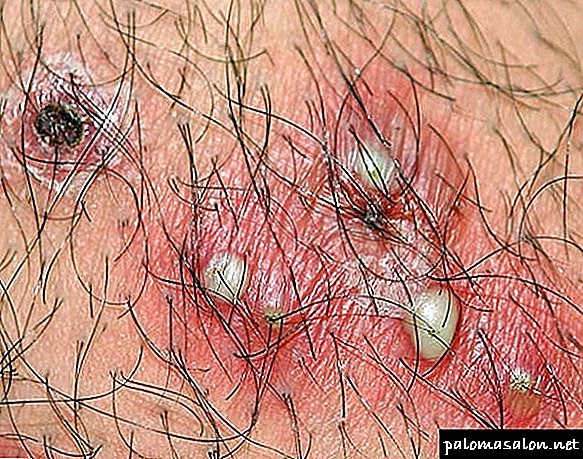
Attempting to squeeze out ingrown hair can damage the hair follicle and aggravate the situation.
How to avoid problems
Prevent ingrown hairs is easier than fighting them. Just a few simple rules will help to avoid negative consequences:
- before the procedure it is better to take a warm shower and exfoliate the skin, but you should be careful with scrubs and peels - you can damage the top layer of the epidermis,
- It is desirable to alternate the methods of hair removal - this will prevent the skin from becoming addictive.If you have already started showing symptoms of this problem, the first thing to do is to replace the razor with wax strips or vice versa.
- during use of the razor should not push it. It should easily slide over the body and remove unwanted vegetation without damaging the top layer of skin cells,
- after depilation, it is useful to treat the area with alcohol tincture of calendula or salicylic acid. So you will prevent clogging of pores, disinfect microdamages and soothe the inflamed areas,
- You should not take a bath immediately after the procedure - a wet and warm environment will provoke the multiplication of bacteria.
By following these rules, you dramatically reduce the risk of problem hairs. But if the unfortunate reddening still appeared, there are several home recipes that will help get rid of them quickly and painlessly.
How to get rid of ingrown hair at home
Ingrown hairs appear when the hair channel is damaged and the hair cannot sneak through thick keratinized skin. Therefore, the first and easiest way to get rid of ingrowth is to gently peel off the top layer of the epidermis. Use a hard washcloth or brush, apply a moisturizer and slowly massage the painful area. Here the most important thing is to keep the golden mean - do not damage the inflamed skin and clean it well. After two days of such procedures, it is likely that the hair itself will unwind and crawl out.

Washcloths, scrubs, brushes - faithful helpers in the fight against ingrown hairs
If this does not work, there are more time consuming but more effective methods. One of the most effective ways is mechanical. It is worth noting that the complete sterility of the whole process is extremely important. In no case should germs and dirt be allowed to enter the open wound, otherwise the situation will only get worse. In such a delicate matter, many women prefer to trust the hands of a professional, and for good reason. After all, only a skilled master will do it painlessly and quickly.
When a hard lump appears, the mechanical method is contraindicated at home. The fact is that the hair is too deep, and in such cases it is worth to consult a doctor. He will open the incision with a sterile scalpel and clean the wound.
For the procedure you will need:
- alcohol or alcohol tincture,
- fine tweezers
- needle.
Removal of ingrown hair occurs in several stages:
- Apply a warm compress to the previously cleansed skin for 3-5 minutes to soften the upper layer of the epidermis. To do this, fit a clean towel dipped in hot purified water or cooled boiling water.
- As carefully as possible with a disinfected needle, pick up a hair and pull it out with tweezers.
- Treat the skin with alcohol.
- If possible, leave on the day with adhesive tape stuck on top to avoid dust and lint.
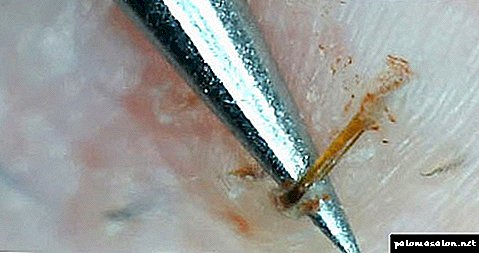
To safely eliminate the problem of ingrown hair, it is better to consult a dermatologist, he will be able to ensure the complete sterility of the process.
But what to do if the boil has already appeared and the edge of the hair cannot be picked up? In such cases, you can help the cream or ointment for acne. Structurally, the problems are very similar to each other, especially when the inflammatory process began. But this means will not save you from ingrown hair, it will only improve the condition of the skin. After it, you should use one of the homemade recipes to release such hairs.
Home remedies for ingrown hairs
Ingrown hair - the scourge of the modern generation. None of the existing methods of depilation does not guarantee its safety. Unwanted inflammations may appear in you, both after the cream and after the razor. Women have been experimenting with folk remedies that have proven their effectiveness for several generations.
Bodyage Mask Recipes
The first in the list of the most effective drugs is medicinal sponge.Many girls know about her magical property - to get rid of posture and redness. But this alga has one more advantage - with its help you can easily and painlessly release the ingrown hairs. The fact is that the bodyaga is ground into a powder that looks like small needles. Their sharp edges scrape the cornified epidermis and promote blood flow.

Dried freshwater sponge has anti-inflammatory and analgesic properties.
If ingrown hairs just appeared in the legs or bikini area, you can use the following simple recipe:
Mix the ingredients in the mush and rub into problem areas for 5-7 minutes. Leave to dry completely. After rinse with running water and treat the inflamed skin with alcohol, tincture or salicylic acid. Moisturizing cream is better to use the next morning. Perform such a procedure twice a week for 2 weeks, and the number of ingrown hairs will noticeably decrease.
After depilation or cleansing the feet, the skin should be “breathed” for several hours. Do not immediately wear pants or warm tights.
If the situation worsens with purulent inflammations, use a drying agent:
- 2 tbsp. l bodyagi
- 4 tbsp. l 3% hydrogen peroxide.
Mix the ingredients and slowly rub into problem areas. Leave on for 5–15 minutes and rinse with water. Owners of dry skin is better not to tighten and wash off the mask as soon as possible. The procedure should be carried out 2-3 times a week for a month.
Often, women experience pigment spots that are caused by improper removal of hair. In such cases, the mask with bodyag will also come to the rescue.
The composition of the bodyagi includes silica. It helps clean the pores at the cellular level, stimulates the regeneration of the upper layer of the epidermis and elastin production. Due to this, the powder of a bodyagi has established itself as a cheap replacement for blush - it causes a slight reddening in the area of application.
Fight ingrown hair with salicylic acid
The second indispensable tool is salicylic acid peeling. You will need 1 or 2% salicylic acid solution and cotton pads. Before the procedure, it is necessary to thoroughly wash the treated area and steam out the skin. The easiest way is to make a compress with a hot towel. After the preparatory procedures, apply a solution of acid on the skin with a cotton swab and leave for 3-7 minutes. A signal that the peeling is time to wash away will be a burning sensation and tingling. Perform the procedure several times over the course of three days, and your skin will become supple enough to allow your hair to burst out.
The hair bulb is deep, and acid will not have any harmful effect on it, but the skin may suffer. This occurs in cases where a highly concentrated salicylic acid solution is used. If after the first application, you do not like the condition of your skin, you need to take a more gentle concentration.
Coffee scrub
When ingrown hairs have just appeared, a scrub of any type will be an effective way to combat them. First of all, we advise you to try a coffee scrub. Caffeine contributes to the production of collagen and protein, which increases skin elasticity.

Coffee scrubs not only help prevent ingrown hairs, but also effective effects in the fight against cellulose
- coffee grounds - 3 tbsp. l.,
- olive oil - 2 tbsp. l
Apply this mixture on the skin and massage for 10-15 minutes. Do not push too hard to avoid damage to the upper layer of the epidermis. Scrub is also useful for preventing the appearance of ingrown hairs and is used before depilation.
Sugar scrub
Another effective tool for the prevention and removal of ingrown hair is a sugar scrub.
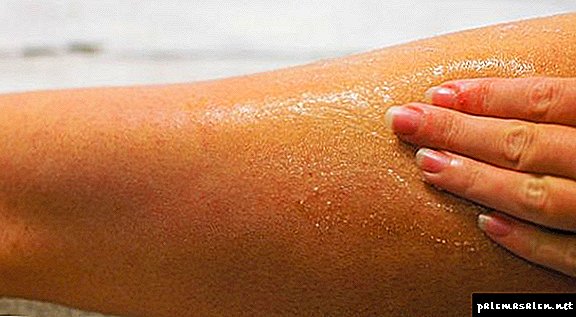
Thanks to scrubbing particles, not only cleansing of hardened skin layers occurs, but also the regeneration process starts.
- 2-3 Art. lcane sugar
- 1 tbsp. l vegetable oil (olive, grape or jojoba).
Mix the ingredients. Apply the mass to cleansed, steamed skin with massaging movements, rinse with water. The procedure is carried out twice a week or before each hair removal mechanically.
Tea tree oil will relieve irritation
Tea tree oil has anti-inflammatory and antiseptic action. Regular use will make the skin soft and velvety. That is why it is based on all sorts of homemade moisturizers and blends.
One of the simple and effective recipes: mix in equal proportions lavender, coconut and tea tree oil. The mixture can be applied to the skin after 4 hours after depilation. During this time, microdamages will have time to tighten, and the skin will get the maximum benefit.
When ingrown hairs, tea tree oil will help reduce redness and itching. To do this, apply it point on the inflamed areas and leave to dry completely.
Aspirin compress
Often in the home use aspirin compress - it is easy to manufacture, and the ingredients are always on hand.
- 2 aspirin tablets
- 0.5 teaspoons of water.
Spread the tablets into powder and mix until a thick slurry forms. Apply to problem areas with massaging movements. Cover with a cotton pad and leave for 20 minutes. A slight burning sensation is a natural result of the action of the active ingredients on the inflamed area.
The porous structure of acetylsalicylic acid works as a gentle scrub. The medicine is famous for its anti-inflammatory effect. Purulent blisters will become noticeably smaller after the first procedure.
Application of Vishnevsky ointment
In the most severe cases, it is recommended to use Vishnevsky ointment. This astringent accelerates the regeneration process, so it is actively used to treat inflammation.
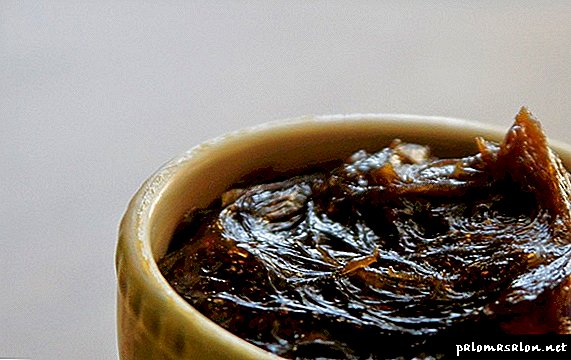
Back in the Soviet Union, Vishnevsky ointment was widely used to treat wounds, irritations and suppurations.
Ointment is applied dotted on purulent boils, covered with a cotton pad and sealed with a plaster. It is advisable to leave a compress for the night, so the tool will be able to “suck out” more harmful microbes. In the morning, the inflammation will be significantly reduced, and one of the methods described above can be applied to exfoliate the skin.
The main active drug in the composition is xeroform powder. It has astringent and antiseptic effect. The tar in the composition of the ointment works as a preservative, which accelerates the effect of other active ingredients and stimulates blood circulation.
How to get rid of ingrown hairs and stains - the main ways
In order to get rid of ingrown hair on her legs, the girl performs the following actions:

After the hair removal, an antiseptic is applied to smooth skin.
If the skin is inflamed, then before the start of hair removal, the girl applies similar antibacterial drugs to her leg:

After the skin has become healthy again, the girl takes a thin needle, picks up the ingrown hair and removes it with tweezers. Then, the woman applies boric acid or another antiseptic to the wound.
A girl should not squeeze or scratch the ingrown hairs with nails and non-disinfected tools. Otherwise, a woman gets inflammation and suppuration on the skin - as a result, pigmented spots appear, which are very difficult to remove.
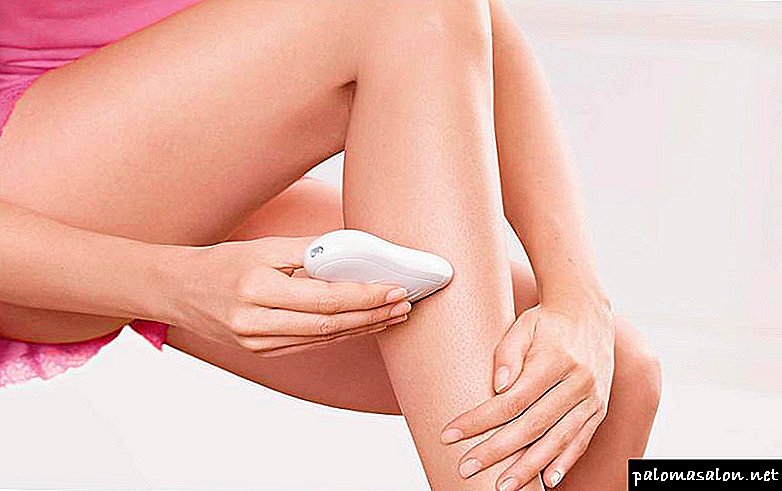
Also, when getting rid of ingrown hairs, the girl uses a scrub with fruit and glycolic acids.
In addition, when removing hairs, a woman can use the medicine from pimples. This therapeutic drug cleans well both acne and ingrown hairs on the female leg.
Ingrown hair removal
First of all: do not touch, try to pull out or pick open the ingrowth. To do everything right, you have to carry out a set of procedures.Firstly, it will help to avoid serious inflammation due to infection. Secondly, the procedures will help to pull out the hair painlessly and without damage to the skin.
The first thing you need to find at home or buy some products that will be needed during treatment. It does not take a lot of time, but most of the items just could somewhere to tumble. So, you need:
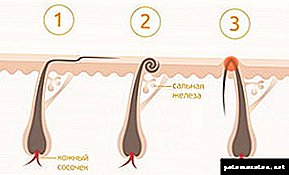 a mixture of sugar and olive oil or a mild scrub bought at the store,
a mixture of sugar and olive oil or a mild scrub bought at the store,- clean washcloth
- sterile tweezers,
- medical alcohol,
- hot water,
- Apple vinegar,
- Coconut oil.
Before aggressively working on the skin, you should always sterilize your instruments, especially when removing ingrowth. Disinfection does not take much time, but it saves from inflammation and infection. To do this, boil tweezers in a saucepan for 10 minutes. Carefully remove and wipe with a clean towel. Then fill a small bowl with alcohol and allow the tweezers to soak for at least 5 minutes.
As for sugar and olive oil, together they are a reliable and effective skin scrub that will help cleanse the skin from dead skin and open the pores. There are many scrub recipes that can be made at home. The simplest one consists of sugar and butter, which must be mixed in a small bowl until they have a moist sandy texture. You can add a few drops of tea tree oil, as it is known for its antiseptic properties. Wipe in a circular motion to remove dead skin, then rinse with hot water and wipe gently with a towel.

Obligatory point - to steam the affected areas to open the pores. To do this, soak a washcloth or towel with very hot water and cover your feet for 10–20 minutes, depending on the sensations. Or you can hold the desired area under a hot shower. For greater effect, you can repeat the procedure several times. This will soften the hair and skin, preparing them for removal.
The last stage will be the direct hair removal, since now nothing will disturb it. It is time to take the prepared tweezers and pull out the ingrown hair. The treatment is useless if you do not grasp properly. In addition, this will reduce the likelihood of re-inflammation. After everything works out, you need to put a heated towel on your skin to soothe her and help her recover faster.
Skin care after the procedure
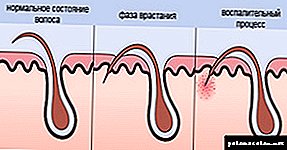 After successful removal, the risks of irritation do not end. Therefore, it is recommended to use additional care to improve the overall condition of weak areas.
After successful removal, the risks of irritation do not end. Therefore, it is recommended to use additional care to improve the overall condition of weak areas.
For example, you can apply natural oils and creams based on them. A light massage with coconut oil can alleviate the irritation and heal the skin gradually. It is best to take unrefined coconut oil, which has a light coconut flavor and a milder effect. It not only heals, but also prevents future ingrowths.
Apple cider vinegar is often used to heal damaged skin. It is usually used over the next few days. You need to put a small amount of apple cider vinegar on a cotton pad and attach to the right place. Apple cider vinegar softens and soothes irritated skin. It also has anti-inflammatory properties that will help get rid of red bumps.
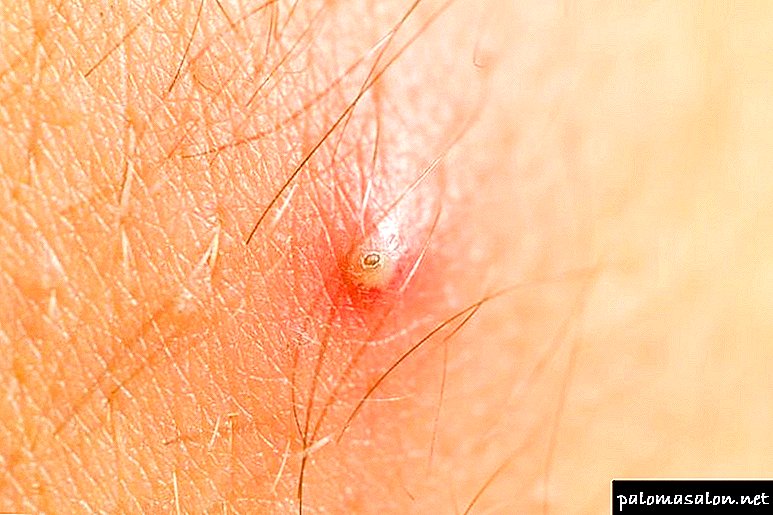
Badyaga or funds based on it are in great demand. You can buy this tool in any pharmacy. Badyaga is a seaweed with needles, which effectively scrubs the skin without letting the hairs grow.
Tea bags
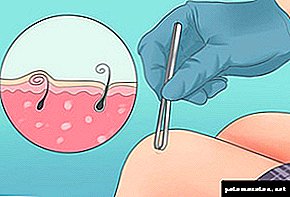 Brewed a bag of strong black tea can help soothe the skin. Black tea contains tannic acid, which reduces redness and inflammation after the procedure. To get the effect, let the bag get wet in warm water and apply to the affected area for 2–3 minutes. If necessary, you can repeat several times a day.
Brewed a bag of strong black tea can help soothe the skin. Black tea contains tannic acid, which reduces redness and inflammation after the procedure. To get the effect, let the bag get wet in warm water and apply to the affected area for 2–3 minutes. If necessary, you can repeat several times a day.
Alternatively, you can use a more complex recipe. To do this, a bag of black tea must be firmly brewed in hot water. Remove it from the water and squeeze all the liquid into a bowl. Mix with one spoon of coconut water. Moisten a piece of cotton in the resulting liquid and gently apply to the irritated skin. Repeat twice a day until improvements appear.
Ichthyol ointment
Popular pharmacy remedy for the treatment of many problems, including ingrowth. In addition, the ointment is able to remove spots that sometimes remain after hair removal. To activate the beneficial properties of ichthyol, it is necessary to apply ointment on the problem area and wrap it with food film or thick cloth. Leave overnight, then wash off under the shower.
Aspirin tablets
Aspirin can help reduce redness and inflammation - the two most common symptoms of ingrowing. The anti-inflammatory property of aspirin reduces swelling, fights inflammation and treats a mild infection. In addition, salicylic acid, present in aspirin, smoothes out dead skin to loosen inflamed hairs. In order to get the effect, you need:
- Soak two tablets of aspirin in one teaspoon of warm water until the mixture becomes pasty.
- Add a teaspoon of honey to the paste.
- Apply the paste to the affected area.
- Leave for 10 minutes. Wash with warm water and then gently pat on the skin.
Repeat the procedure once or twice a week as needed. In addition, people with sensitive skin should not try this treatment.
Baking soda
Regular baking soda has a calming effect on the skin due to its anti-inflammatory properties. In addition, it helps relieve itching, exfoliate the skin, and reduce redness caused by ingrown hairs.
Soda works as an excellent exfoliating agent and at the same time promotes an increase in blood circulation, promotes healing and reduces puffiness. For this you need:
- Mix 1 spoon of baking soda in a cup of warm water.
- Dip a small piece of cotton in the mixture and gently wipe the skin.
- Do not touch for several minutes, then rinse thoroughly with water.
- Do this twice a day until the hairs come out.
However, it is worth considering that this method will not work if, after the first use, the skin is reddened and inflamed.
Ingrowth prevention
If you are tired of thinking about how to get rid of ingrown hair on your legs, it is best to introduce into the habit of several useful procedures aimed at preventing ingrowth. Need to remember simple rules:
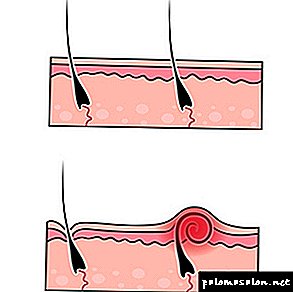 Skin and hair love moisturizing. Regular moisturizing is the golden key to prevent ingrown hair, especially painful ingrown pubic hair. Many people regularly moisturize their face, hands and feet, forgetting about the pubic area. The skin in the pubic area is especially susceptible to ingrown hair, and regular moisturizing does wonders. This adds a protective barrier during the shaving process, soothing the skin and preventing irritation thereafter.
Skin and hair love moisturizing. Regular moisturizing is the golden key to prevent ingrown hair, especially painful ingrown pubic hair. Many people regularly moisturize their face, hands and feet, forgetting about the pubic area. The skin in the pubic area is especially susceptible to ingrown hair, and regular moisturizing does wonders. This adds a protective barrier during the shaving process, soothing the skin and preventing irritation thereafter.- Buy a good razor. A dull razor not only increases the chances of ingrowth, but can also cut the skin. According to statistics, disposable blades must be changed after 3-4 uses. Such a trifle, as the sharpness of the blade, is of great importance for the integrity of the skin and hair.
- Forget about epilators. Although home epilators are advertised as an effective home remedy for hair removal, they hide dangers in themselves. So, hair ingrowths often occur due to improper exposure of the epilator. It removes the hair from the wrong angle, thereby disrupting its growth, which leads to ingrowth. Denial of the epilator can significantly affect the problem.
- Make peeling part of your care. Exfoliation of dead cells really helps to regenerate the skin and reduce stretch marks.Before shaving or epilating, it is very important to clean the skin from impurities and dust. Just a couple of extra minutes will help hairs grow smoothly, without irritation and pain.
- Laser hair removal. If financial opportunities allow, you can take a course of laser hair removal. It can not only slow down the growth process, but even with a long course it can permanently save you from unwanted hair and problems with them. After the first three sessions, the first visible results will appear.
Practice shows that the use of several measures to prevent ingrowth can permanently relieve this problem. In addition, it will improve the overall condition of the skin, while even the most careful removal leads to its damage.
After shugaring or even regular shaving, I always massage the skin of the legs with regular pumice. I pre-lubricate the skin with a gel or cream, so as not to harm the sensitive areas. I am mass without fanaticism, but slightly quite. From growing into really helps. I spend more time on the massage for the first two days after epilation, and then sometimes I go quickly for prevention. Additionally, I do not use anything.
I struggled with this problem for a long time. At first, like many, I tried to scrub, get wet, bought different serums from ingrowing, smeared with bodice, and even consulted a dermatologist. But for me it did not work. Everything changed when I tried another remedy - ichthyol ointment, or “ichthyol”. You can buy it in any city, and the price is absolutely ridiculous. Applied on ingrown hairs and wrapped up with plastic film. In this form, went to bed, and the next morning washed away. I usually repeat this procedure every other day until the hair breaks through. It is important not to wrap the film too tight.
I go on removal by the laser three years. The first time was to visit a specialist every 2–3 months, now I can afford not to go for six months. By this time, the legs on the legs practically stopped growing, but from the bikini area and underarms they leave longer. Most importantly, there is no more ingrowth. I forgot about epilators at all and now I remember only like a bad dream. I do not recommend it to anyone, as they only aggravate the situation. The only difficulty with laser therapy that may not find a good specialist in your city, and this is the main criterion.
Prevention methods
After a grueling fight with the problem and getting smooth skin, the last thing I want to do is repeat the unpleasant experience. The solution is quite simple: if you enter into the depilation procedure a set of simple rules, you can reduce the risk of ingrowth to a minimum. Prevention:
- on the eve of a scheduled vegetation removal session, it is worth doing a scrub or peeling,
- Before epilation, be sure to steam the skin to open the pores,
- Depilation is carried out on wet skin for hair growth. Dry epilation - against,
- after the end of the skin is treated with an antiseptic, and after a means of slowing down the growth rate of hair,
- depilation should not be done more often 2-3 times a month,
- for prevention, it is worth wiping the skin with salicylic acid solution every day,
- 3 days after epilation, the use of scrub or peeling is allowed.
User Reviews
Marina, 24 years old: “Problems appeared after the purchase of the epilator. At first she did not want to believe, but then she had to admit the obvious. Rescued by steaming and coffee scrub. I liked the effect.
Tatyana, 32 years old: “The mixture of hydrogen peroxide and bodyagi performed a miracle. I suffered from growing into several years. And it turned out, everything is so easy. She made a course for 7 days. Now I repeat sometimes for prevention. ”
Alina, 20 years old: “I do not trust purchased means, even pharmacies. The skin is incredibly sensitive and prone to allergies. The exit for me was a scrub with aloe. Moisturizes and does not cause irritation - perfect! ”
In the future, not to ask the question: how to get rid of the ingrown hair on his legs, you just need to follow some simple recommendations and rules. Their implementation and attentive attitude to their own health will surely give them smooth and even skin.
How to prevent ingrowth?
To avoid this scourge, you must perform certain daily procedures:

- The first thing to do is to steam the body well,
- remove all balances
- easy peeling procedure
- treat problem areas with lotion,
- if there is even a slight irritation on the skin, stop shaving,
- on the third day after depilation, you can rub the skin with a stiff sponge,
- Do not forget to thoroughly moisturize your body daily.
Also, to minimize the chance of this trouble, you must follow some rules:
- the best way is to carry out the procedure of hair removal in a good salon,
- once in 7 days do a peeling with a hard scrub, it will rid the skin of dead particles,
- before the procedure, always steam the body well,
- shaving hair is necessary for their growth, and remove the wax - against,
- getting rid of vegetation should not pass over dry skin, use specially designed shaving products,
- replace used blades regularly
- To relieve irritation, you can apply acne treatment to your body, salicylic acid is included in it.
These simple procedures will not only help to prevent ingrowth, but also remove stains after them.
Elimination of ingrown hair with suppuration
When infectious agents get into the follicle, a abscess forms around the ingrown hair. It is important to know that it can not be squeezed out! Otherwise, the follicle will be a strong external influence, from this he is injured, and his position changes. Consequently, in the future there will constantly grow hairs.
An abscess with ingrown hair is eliminated in the following sequence:
- Need to take a thin needle and tweezers.
- The ingrowth site and tools need to be sanitized.
- Needle gently to make a puncture in the purulent focus.
- With the end of the needle, pry the hair and pull it out.
- Tweezers pull the hair loose.
- The place of ingrown hair must be treated with an antiseptic composition (Miramistin, Chlorhexidine, peroxide, etc.).
- Continue to treat the wound with disinfectant for 2-3 days.
Cosmetic procedures for removing pigment spots
In most cases it is easy to get rid of ingrown hairs by home remedies. But, if a serious inflammation has begun, the pigment spot or scar will most likely remain. Often, such defects appear when the hair is squeezed out along with pus. To remove age spots worth visiting beauty salon.
Laser cosmetology is one of the achievements of modern science, which makes it possible to solve a whole range of skin problems. Under the influence of light, blood circulation and cell regeneration are accelerated. This contributes to the rapid healing of damage and renewal of the upper layer of the epidermis.
Laser polishing allows you to work only on problem areas and eliminates defects in a short period of time. During the procedure, a concentrated beam of light destroys only cells with an excessive content of melanin pigment - instead of them, new and healthy ones appear. The operation takes from 5 to 20 minutes, and the recovery period does not exceed three days. Before carrying out this cosmetic procedure, you should consult with an experienced dermatologist.
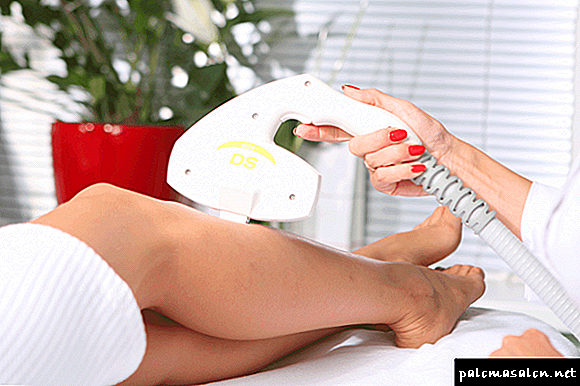
Laser exposure also destroys damaged and weakened hair follicles - the appearance of ingrown hair stops after the procedure
To get rid of post-acne and age spots, phototherapeutic methods are also used. The process itself is similar to the effect of a laser - concentrated light rays are directed to the affected areas.During the procedure, a pulsed wave of a certain frequency destroys the pigment itself in the epithelium cells. After phototherapy, a slight reddening may occur, which passes in 1-2 days.
The greatest amount of melanin is contained in the upper layers of the skin, so an effective tool in the fight against the unpleasant effects of ingrown hair is chemical peeling. Strong skin cleansing during a cosmetic procedure is similar in nature to a light burn. The recovery processes are sharply activated, and a new surface layer of skin with a lower pigment content is formed. Depending on the extent of the damage, you may need a superficial, midline or deep peel. Before visiting the cosmetology office, you should consult a dermatologist.
What to do if an ingrow has occurred?

Today there is a large range of cosmetics from ingrowth, which can prevent the problem. Prices for these drugs are in a fairly wide range. However, these tools based on natural ingredients can be prepared at home.
For the treatment of ingrown hair on the legs, methods are known by which you can combat this problem with self-made preparations.
To cope with the problem, you can use this instruction:
- Using a home scrub, remove the coarse epidermis. It is made from 0.5 cups of salt "Extra" and 2 teaspoons of orange oil. After mixing, add body cream, to obtain a dry mass. The mixture is treated with the body, it can be done every time you do water treatments.
- Now you need to rinse the skin with enough cold water. This will help her recover faster.
- You should not rub the skin with a towel, it is quite enough to just wet it and treat with calendula tincture and salicylic alcohol in a 1: 1 ratio.
- Let it dry and apply light baby oil on your skin.
For prevention, experts recommend that such treatment is carried out daily. If there are stains from ingrown hairs on your legs, you can get rid of them by one of the suggested methods.
The following methods are still popular:
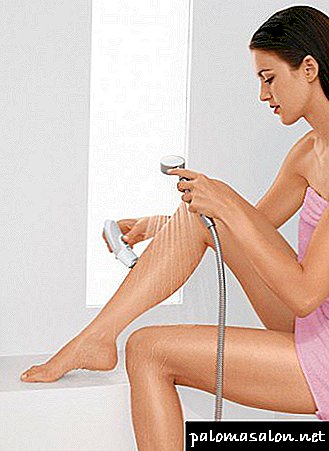
- It is necessary to prepare a means of bodyagi and hydrogen peroxide. The powder is combined with a liquid to obtain a mixture, the consistency of sour cream. Means cover the skin of the feet and leave for 15 minutes, then rinse with water. This mixture perfectly stimulates cell growth and makes it possible to break a hair in a shorter period of time. For greater effect the day before the depilation, use a hard scrub.
- Another problem can be solved with ichthyol ointment. It is applied on the body with a small layer and wrapped in film and left overnight. Already in the morning hairs will appear, which will give you the opportunity to remove them with tweezers.
- Use a compress. In a glass of water, dissolve 2 aspirin tablets. Cover the area that has been inflamed with a rag soaked in the composition. You need to hold such a compress for at least 60 minutes,
- You can bring to the treatment of bodyguard. It is diluted in water and rubbed the body. The downside is dry skin, so apply a waterspout no more than 2 times in 7 days,
- The following composition is ideal for rubbing in: 30 g of alcohol, 2 g of iodine, 12 g of ammonia and 7 g of castor oil. After 15 minutes, the solution is washed off and must moisturize the skin.
- Changing the way to get rid of unwanted vegetation can also save you from the problem.
- Coffee scrub. Due to its high abrasiveness, it easily removes coarse dead cells, making the body very soft. The main ingredient is natural ground coffee. You can also add any essential oil. This scrub for feet from ingrown hair can be used continuously. Coffee can be replaced with sugar or salt.
How to remove ingrown hairs
If this is not a global problem, you can handle them yourself. You will need: tweezers, needle, cotton wool and hydrogen peroxide. Having disinfected tools and skin, you can proceed.If the end is visible, just grab it with tweezers and pull it out. When the hair is completely under the skin, you need to work with a needle.

Make a puncture in the epidermis and pick it up, and then you can remove it with tweezers. Now disinfect and seal the area with a plaster to avoid bacteria.
If the problem of ingrown hair is global, it is better to consult a specialist. This may be a surgeon or a master in a beauty salon. Thanks to knowledge and technology, he will be able to remove this nuisance without harming the skin.
Remember that if the hair has grown very deep, you can get a serious infection, so do not bring it to this state, but solve the problem immediately.
Now you know exactly what to do on legs with ingrown hair. Apply for the treatment of folk remedies or consult a specialist - the choice is individual.
The main thing is to remember that this problem should be solved immediately after the appearance in order not to spend big money on expensive medicines in the future.
Video: dermatologist on laser hair removal
The same problem, now I try to wipe it with salicylic acid (2%), it costs a penny, but the effect is very even. While still at school, he tried it when fighting pimples - dries, relieves inflammation, and exfoliates. For a month of such procedures, improvement is evident - the spots become less noticeable, the skin becomes smooth, and even the hairs grow less and slower.
Daria
I personally badyaga helps, and the bath, too, by the way! There is practically no ingrown hairs now, I got rid of it in 8 months with the help of bodyagi + sea, then I continued with baby soap and oils, sea salt and pumice. If I pick it up, especially in the bikini area, then salicylic and zinc ointment will help. In general, I tried everything and finally got rid of ugh - ugh, but I continue every day with sea salt and pumice just in case
Irina
I was advised by a very good friend to fight the ingrown hairs with salicylic acid solution. Since then, for me, this tool is number 1, and I do not even look in the direction of all these expensive creams. Just wetting a piece of cotton wool or a cotton swab in a solution and lubricates the inflamed area. After 1-2 days, the skin in this place begins to peel off and the hair breaks out. And it is already easy to remove with tweezers. I once had a hair 2 cm deep under the skin, began to wrap there. That's when I tried this tool for the first time. After hair removal, be sure to smear this place with the same solution.
Ksyusha
For a bikini - I made electrolysis - now “there” for many years nothing grows, with the help of EE it is also possible to remove ingrown hairs strongly (there is a master with glasses-magnifying glass. With pointed hands and very thin needles). Doing EE on the legs is expensive. While saving creams for depilation (I just do not grow anything from this method and there is no irritation). Plus cream over time, slightly softens the skin and hairs that are grown, are shown on the surface and are available for removal.
NATlink
I use the machine, I try to get the skin steamed, I scrub a little (gently, if I may say so). The most important thing is that when the hair grows in, do you feel and see redness? In this case, I take a thin needle and gently hook a hair - it goes out easily, the inflammation passes very quickly. True, it is not always possible to keep track, so I personally have ingrown hairs appear about once every two to three months.
Safo
I have everything the same, but unfortunately I can not refuse from the epilator yet! From razor prickly faster than a day! Now there is a lot of ingrown hair! I pick a needle .. there are red sores .. then they turn blue. Their bodjuju I smear ... pass!
Likuha
I have problems with ingrown hair on my legs for a long time. It all started after using the epilator. What did not try - scrubs, hard brushes ... Even wiped the skin with salicylic acid. Helped somewhere by 25%.Summer began to hate, because in shorts or in a skirt in the heat I cannot go outside, even through thin caps black dots are visible. So, recently decided to try to smear the badyagu to his feet. What I want to say. HELPED! Realistically. Even I can not rejoice. Therefore, I share with you.
Snazzy
Today, any woman who has ever removed unwanted vegetation can face the problem of ingrown hair. The appearance of ingrown hairs depends on many factors, but you can cope with them. There are lots of recipes that help to forget about the hated black dots. All you need is to find a way that suits you.
Tea tree scrub with scars, spots and bumps
Using this scrub, the girl brings the hairs closer to the skin surface and also heals wounds.
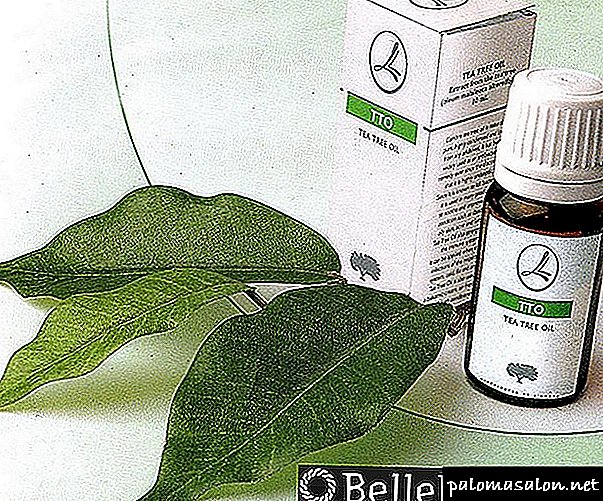
In the manufacture of such tools girl performs the following actions:
Such a scrub from ingrown hair softens and disinfects the skin.
After-shave badyug powder
When using the scrub from badyagi powder and hydrogen peroxide, the girl performs the following actions:
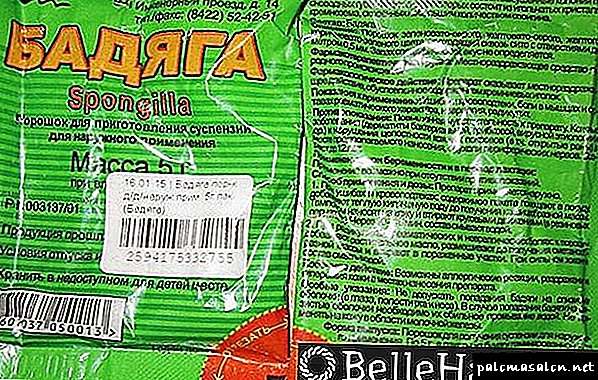
A woman conducts a similar procedure for 5 days. When carrying out such procedures, the girl permanently gets rid of ingrown hairs, wounds and spots after them.
The use of aspirin and glycerin after shugaring
When applying a cosmetic composition of aspirin and glycerin, a woman performs the following actions:
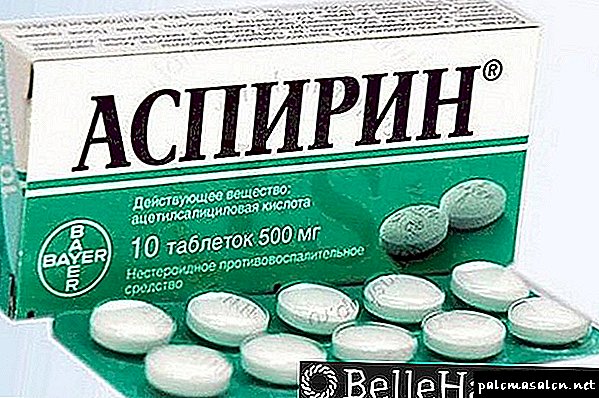
When using such a tool, the girl pulls out hairs to the surface - facilitates the process of its removal.
Badyag ointment from wounds and dark spots
Often, after removal of ingrown hair, pigment spots appear on the leg. When they are removed, the girl performs the following actions:
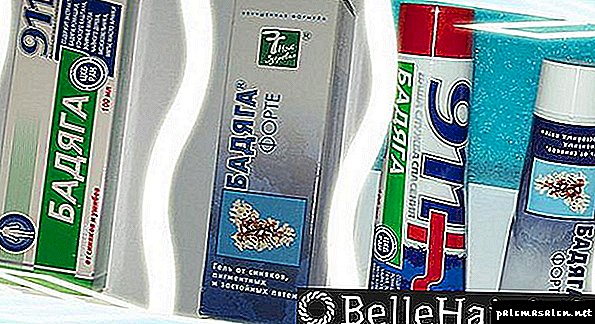
Also, when removing extra pigment spots, a woman uses salicylic ointment or Troxevasin ointment, which she lubricates the skin 2 times a day.
How to prevent ingrown hairs after epilation - preventive measures
When carrying out prophylaxis to prevent the formation of ingrown hairs on the leg, the girl performs the following actions:
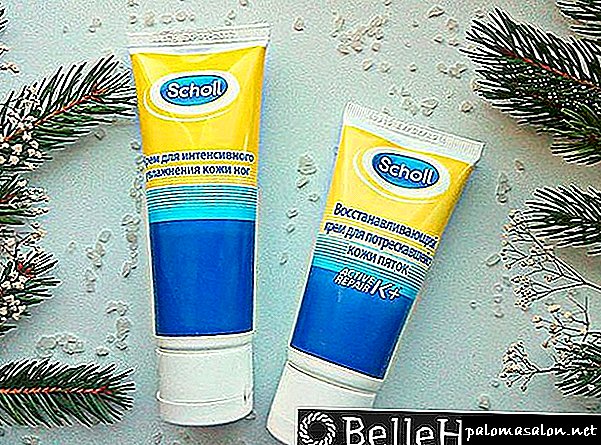 Remember that it is easier to prevent this or that problem than to treat it.
Remember that it is easier to prevent this or that problem than to treat it.
According to trichologists-specialists in hair, a girl should not remove ingrown hairs - perform epilation during critical days or when a woman is very upset - the effectiveness of the procedure will be equal to 0.
Salicylic acid
Salicylic acid is a component of many cosmetics intended for skin peeling. The drug has an exfoliating effect on the skin. In addition, salicylic acid prevents the development of inflammatory processes and promotes the healing of already formed purulent foci.
To combat ingrown hairs, a solution of the drug with a concentration of the active substance of 2% is used.
Apply the remedy as follows:
- Moisten a cotton swab in salicylic acid.
- Dot treat problem areas.
- Repeat the treatment 3-4 times a day.
- After 4–5 days, the skin will peel off, and the ingrown hair will be loose.
- Hair should be carefully pulled out with tweezers.
- Process ingrowth antiseptic.
- Lubricate the wound with a disinfectant to complete healing.

Ointment against ingrowth
At home, you can make an ointment against ingrown hairs. To do this, take:
- salicylic ointment - 1 tsp.,
- zinc ointment - 1 tsp,
- Bepanten - 1 tsp.
All components are thoroughly mixed and applied to the skin of the legs twice a week. Zinc ointment effectively dries inflammation, and Bepanten soothes the skin.
Badger Recipe
Badyagi powder can be purchased at any pharmacy. Badyag is a freshwater sponge whose skeleton consists of silica. Therefore, the ground badyaga is a microscopic needle.
The tool is used in many peels, because it can soften and exfoliate the stratum corneum.
At home from ingrown hairs apply the following recipe.Must be mixed:
- badyagi powder - 1 tsp,
- hydrogen peroxide - 1 tsp.
Then the mixture is used in this way:
- Apply to the problem area a compound with a badag (do not rub it!). On the skin will feel a slight tingling, and even burning.
- After 10–15 minutes wash off with warm water.
- Moisten the treated area with cream.
- Usually on a 2-3 day hair clears up, and it must be removed with tweezers.
- Process ingrowth antiseptic.
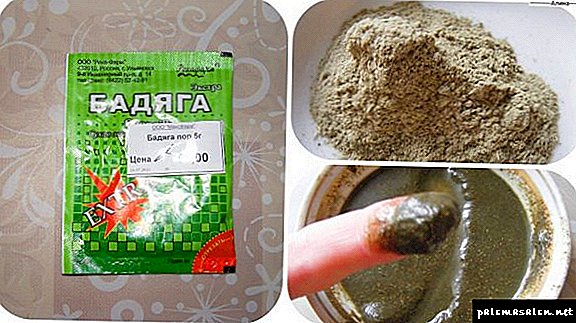
Preparations for ingrowth
The action of the finished cosmetics from ingrown hairs is also aimed at softening the stratum corneum and exfoliating dead skin cells. As the main active ingredient, they often contain salicylic acid (Depileve Lotions Bottle lotion for ingrown hair, Gloria ingrown hair gel, Bliss disks for ingrown hair, etc.).
In addition, manufacturers include herbal extracts, fruit acids and other components in the finished products, so these products not only prevent ingrowth, but also take care of the skin and significantly slow down the growth of new hairs (for example, ARAVIA Professional 2 in 1 spray lotion ).
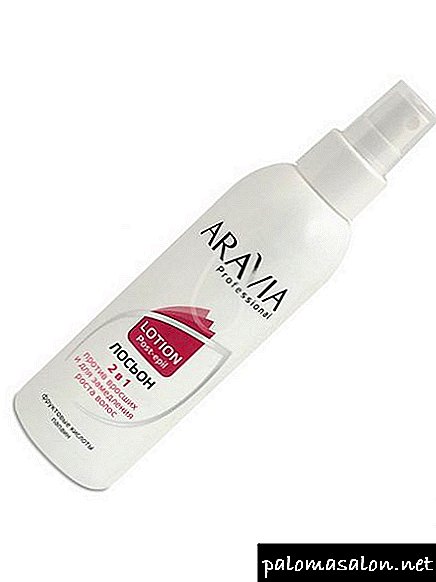
Stains from ingrown hairs
Often, on the site of ingrown hair, the skin changes its color and becomes blue. This is nothing like a little bruise. When the follicle is damaged, the small blood vessels that feed it often break. Part of the blood flows into the extracellular space and thickens there. Therefore, a darkening of the skin surface is observed.
You can bring the skin in order with ready-made preparations and home remedies.
Gel Badyaga 911
Badyaga is considered the No. 1 remedy for hematomas. The substance irritates the skin by activating the flow of blood to its surface. It promotes the resorption of blue spots.
The gel should be applied to dark areas daily for 5–7 days before bedtime. The drug is effectively absorbed and does not leave greasy stains.
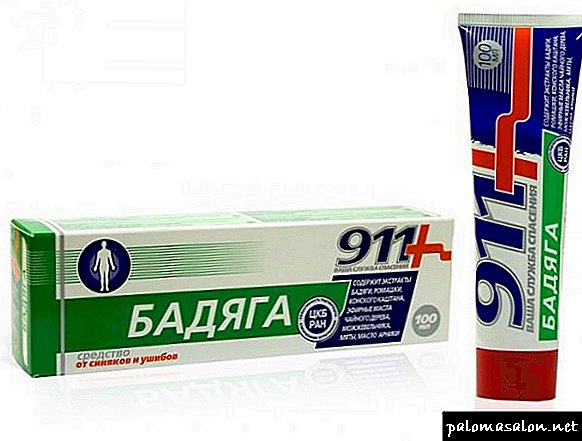
In the composition of the gel, the leech extract acts as an active substance, which dilutes the blood and accelerates its circulation.
The gel is applied to clean, dry skin. It can be used up to 5 times a day until dark spots disappear.
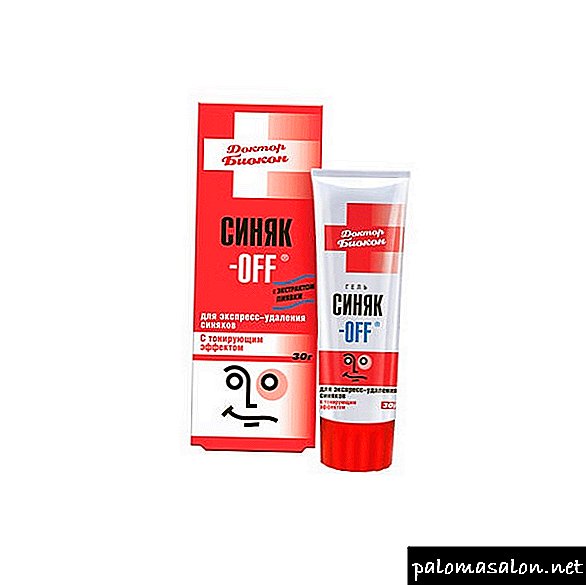
Cream Balsam Ambulance
The name of the drug corresponds to its rapid action. Cream-balm contains a whole "team" of active ingredients that effectively thin the blood and absorb the hematoma:
- badyag powder,
- camphor,
- Ginkgo biloba extract
- lavender extract, etc.
Balsam Ambulance is applied 2-3 times a day until the problem disappears.
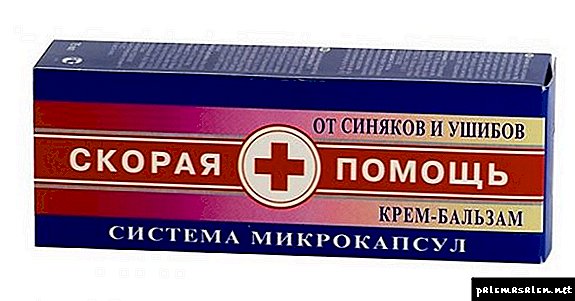
Fruit acid use
Under the influence of acid, the skin is also lightened. At home against bruises, you can use the tool, which consists of the following ingredients:
- lemon juice or apple cider vinegar - 4 tsp.,
- white clay - 3 tsp,
- tea tree oil - 3 drops.
Clay diluted with lemon juice or vinegar. Add the tea tree extract to the mixture. Apply the product on a blue stain and rinse with warm water after 20 minutes.
Tea tree oil in the mask contributes to the healing of the skin after removal of ingrown hair.

Means with parsley and kefir
To get rid of blue spots on the skin at home, you can use parsley juice and kefir, which in cosmetology are known for their whitening properties. In addition, vitamin A, which is part of parsley, allows you to quickly heal damage to the skin after ingrown hairs.
- parsley juice - 1 tsp,
- lemon juice - 1 tsp,
- kefir - 1 tsp.
All components are mixed. The composition is applied to the problem area and washed off after 20 minutes. The mask can be done daily until the blue spots are completely absorbed.
I have problems with ingrown hair on my legs for a long time. It all started after using the epilator. So, recently decided to try to smear the badyagu to his feet. Who does not know, Badyag is a freshwater sponge, has a peeling and excellent absorbing effect.A lot of girls use it from spots after acne, scars. So here. I decided to try, because there is nothing to lose. At first, she slightly steamed her legs, and then ... Recipe 2–3 tbsp of badyagi 5 tbsp of water. Stir and rub into the skin for 4–5 minutes. Do not rub hard! And then left to dry for 30 minutes. Washed away. What I want to say. It helped! Realistically. Even I can not rejoice.
Snazzy
Badyag is a freshwater sponge, which, when crushed, forms small particles resembling needles. When rubbed into the skin as part of a gel or ointment, they cause irritation and redness of the skin. Due to the rush of blood sores and stagnant spots dissolve very quickly. Badyaga is an effective remedy for ingrown hair, but you need to be careful with it. You can use the gel with badagi in between hair removal. However, this procedure should not be too frequent, because the increased blood flow causes not only the rapid healing of spots, but also the acceleration of hair growth.
Jeanne
Lotion should be used a day after the procedure. But I do not read anything. Why should I bother myself? And put it right away. Many times, until 15 times I accidentally read it. No unpleasant consequences occurred. But there are pleasant moments. The lotion won me over by its ability to soothe irritation in a matter of minutes. Ingrown hairs really get smaller. I don’t know about the slowdown ... I don’t really believe it. But as a naive person, I was impressed and it even began to seem that growth really slowed down. But to track it for me, with the help of rulers or any other devices is not possible. I do not want to grow anything, it is too long in time, not aesthetically pleasing, and laziness is easy for me.
Crappy girl
Ingrown hairs on the legs may appear in violation of the technology of depilation or due to individual characteristics. Eliminate ingrown hairs can be on their own, using ready-made or home remedies.

 a mixture of sugar and olive oil or a mild scrub bought at the store,
a mixture of sugar and olive oil or a mild scrub bought at the store, Skin and hair love moisturizing. Regular moisturizing is the golden key to prevent ingrown hair, especially painful ingrown pubic hair. Many people regularly moisturize their face, hands and feet, forgetting about the pubic area. The skin in the pubic area is especially susceptible to ingrown hair, and regular moisturizing does wonders. This adds a protective barrier during the shaving process, soothing the skin and preventing irritation thereafter.
Skin and hair love moisturizing. Regular moisturizing is the golden key to prevent ingrown hair, especially painful ingrown pubic hair. Many people regularly moisturize their face, hands and feet, forgetting about the pubic area. The skin in the pubic area is especially susceptible to ingrown hair, and regular moisturizing does wonders. This adds a protective barrier during the shaving process, soothing the skin and preventing irritation thereafter.